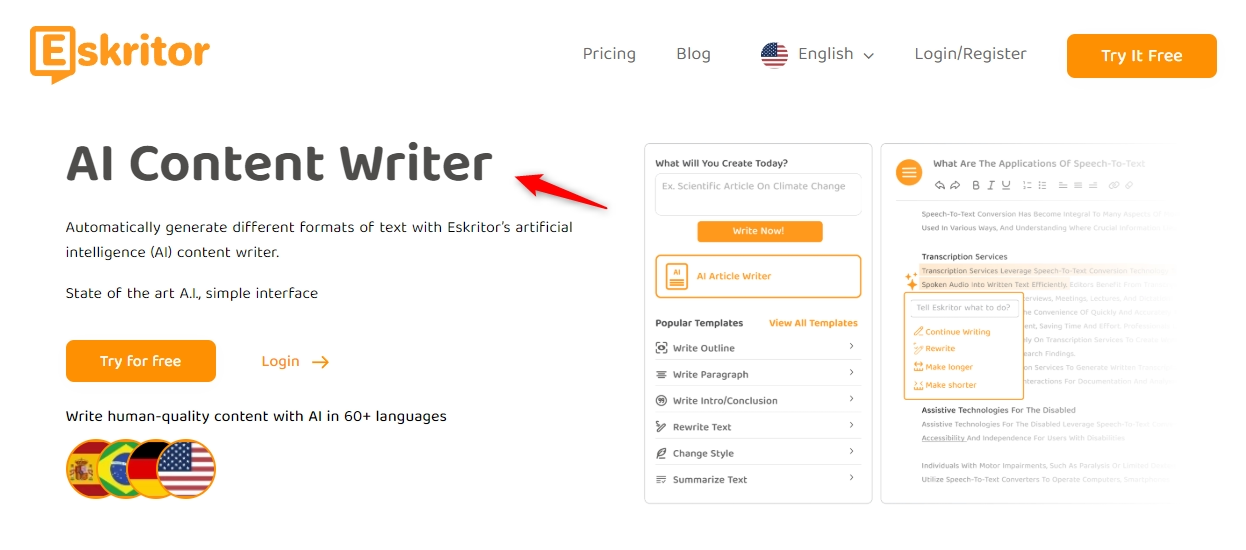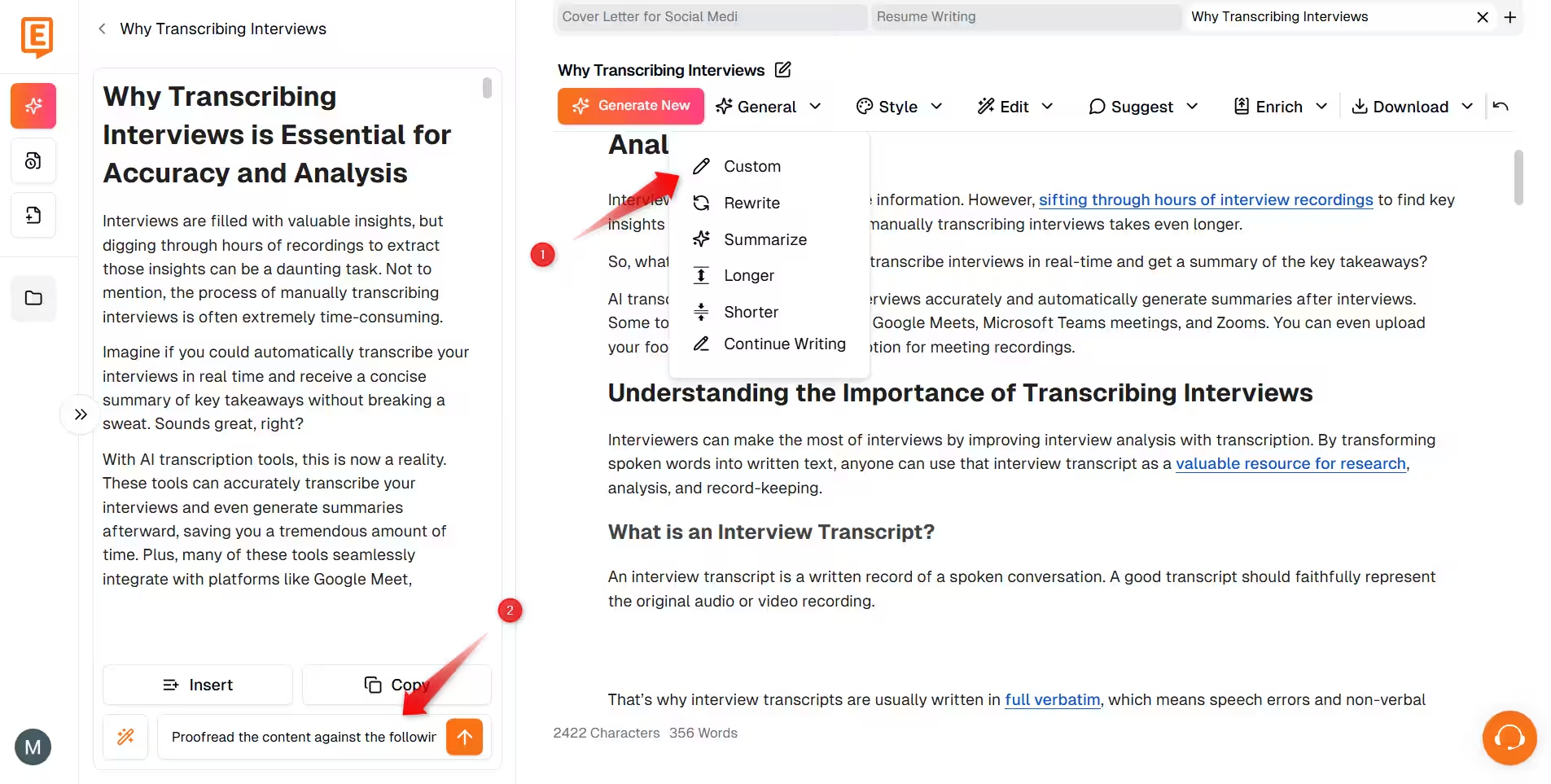Brand building is more than scaling sales and operations. It’s also a long-term campaign to make your brand a cornerstone in your niche through excellent service and a recognizable brand voice.
Apple is a successful brand voice example, known for creativity, minimalism, and elegance. Even non-Apple fans understand Apple’s products and branding. This brand voice nurtures customers into becoming brand ambassadors and increasing their customer lifetime value (CLV).
However, maintaining a consistent brand voice across blogs, social media, and other content is a significant challenge. But what if there was a way to streamline this process and ensure brand voice consistency across the board? This is how AI tools can help.
Understanding Content Marketing Strategy Fundamentals
Before talking about AI, let’s first understand the fundamentals of content marketing and its key components.
What is a Content Marketing Strategy?
A content marketing strategy is a plan for creating and distributing valuable, relevant, and consistent content. Usually, to attract and retain a clearly defined audience and then influence them to take action.

In short, it’s your business’ strongest weapon for multiplying your customers and increasing sales through content.
Key Components of Successful Content Marketing
To achieve this, a digital content marketing plan needs to cover several key bases. Here are the core components of successful content marketing examples:
- Target Audience Definition: A thorough overview of your ideal customer through a buyer persona.
- Content Goals: Brand awareness, drive traffic to your website, or generate leads?
- Content Calendar: Ensures consistent, steady publishing of valuable content to your audience.
- Content Formats: blog posts, videos, infographics, podcasts, and social media.
- Distribution Channels: Identify the platforms where your target audience spends their time. Tailor your distribution b2b content strategy accordingly.
- Performance Measurement: Track key metrics like website traffic, engagement, and lead generation to assess the effectiveness of your content.
- Brand Voice: This is the personality of your content and is the most crucial element for building long-term relationships.
While all these elements are essential, your brand voice is critical to a successful, long-term content marketing campaign.
Why Brand Voice Matters in Content Strategy
Marketing is about influence. Good marketing influences people's brains toward a decision, usually a purchase. This influence can be conscious, like a limited-time discount or an offer. However, the most powerful influence is subconscious persuasion, like the impact of colors, design, and, crucially, a brand voice.
These elements bypass the logical mind and connect with emotions, creating a sense of familiarity and trust.
It's a long-term game. Months and years down the line, when a potential customer finally lands on your website, it will feel familiar to them. This familiarity will make them likelier to convert into customers.
Building Your Content Strategy Framework
A content strategy is a high-level forecast of how your content will look, feel, and perform. That's why a solid framework is absolutely essential in setting up that forecast for success.
Setting Clear Content Marketing Goals
The SMART framework stands for Specific, Measurable, Achievable, Relevant, and Time-bound. According to a scientific study, this framework helps you set goals that are easier to follow.
A vague objective like "increase brand awareness" might be your current goal. But the SMART framework would reword this as "Increase website traffic from organic search by 20% within the next quarter by creating and promoting two high-quality blog posts per week targeting keywords related to core product features."
This specificity allows for accurate progress tracking, identification of successful tactics, and strategic content planning. More importantly, it allows everyone in the team to know exactly what “increased brand awareness” looks like.
Defining Your Target Audience
Great strategies are specific, so specifically define your target audience through personas. A buyer persona is a semi-fictional representation of your ideal customer. It’s based on market research and data about your existing customers. A persona dives into their psychographics, motivations, goals, and pain points, making your audience more tangible and relatable.
For example, instead of "small business owners," your persona is a 35-year-old marketing manager. Her name is "Marketing Mary," and she works at a SaaS startup that struggles with lead generation and content creation.
Content Audit and Gap Analysis
A content audit systematically categorizes and identifies gaps in your current content library. What topics are already well-covered? Where are the shortcomings? This also prevents redundancy and ensures every content serves a distinct purpose.
You can use a simple spreadsheet to effectively track and audit your content. To help you assess a content idea's value, ask yourself if pursuing it will help your business. Consider both the short-term and long-term impacts.
Resource Assessment and Planning
Resource assessment and planning are the bedrock of successful content marketing ROI. It's where strategy is translated into action steps for the entire team.
Here are two high-level tips for effective resource assessment and planning:
- Prioritize ruthlessly: Focus on the 20% of activities that will generate 80% of the results. Ruthlessly prioritize these high-impact initiatives and allocate your resources accordingly.
- Build flexibility: Regularly review your resource allocation, track performance, and adjust as needed.
You don’t have to follow your brand content strategy strictly. But, if you deviate from it, make sure to track and log any changes. Data is your friend, and tracking it will help you develop better content strategies in the future.
Developing Your Brand's Unique Voice
Developing a brand voice is more complicated than choosing a few descriptive words. And if you get this wrong, you'll spend time and money creating content that either muddles your brand identity or actively hurts it. This entire section is dedicated to helping you get this crucial step right.
Brand Voice Guidelines Creation
A brand voice is a combination of the brand’s unique traits. Are you a premium service? Authoritative? Playful? Exclusive? What is the position of that brand in the market?
Once you have an idea of your brand voice, create these guidelines:
- Create a Language Palette: These are words and phrases your employees should frequently use. Include specific examples, like 'Let's explore this together' instead of 'You must do this.'
- Develop a "Don't Say" List: This clarifies what language is off-limits. Examples are. "We don't use condescending or overly technical language." or "We don't use slang or overly casual language that could be misinterpreted."
Identify your brand's unique traits by finding similar companies in different industries. Are you the Ryobi of cameras? This means your target audience is hobbyists who need reliable equipment. Hence, your brand voice should be reliable but affordable.
Creating Brand Voice Documentation
A brand voice document is the guidebook for anyone who creates content for your brand. It typically includes:
- Introduction: Explain the document's purpose and who should use it.
- Brand Values/Mission: Connect the voice to the core principles of your brand.
- Brand Personality: Define the key characteristics of your brand in 3 to 5 adjectives. E.g., friendly, professional, innovative, as if it were a person.
- Target Audience: Your ideal customers in the form of 3 to 5 personas.
- Tone of Voice: Explain how the brand's voice adapts to different situations. This section often includes a spectrum or examples of how the voice changes depending on the context. E.g., formal vs. informal, serious vs. lighthearted.
- Language Palette & Don’t Say List: Add lots of examples of the brand voice in different content. Like web copy, social media, blog posts, newsletters, videos, etc.
- Updates/Version Control: Track changes to the document over time
Content Marketing Best Practices for Brand Consistency
Now that you understand the importance of brand voice. These content marketing best practices will show you how to implement them across all your channels.
Measuring Content Performance Consistently
Use social listening and content marketing tools to monitor brand mentions and sentiment. Are people responding positively to your brand voice? Use this data to refine your brand voice guidelines and make them even more impactful.

Track your content's performance using key KPIs like website traffic, engagement (likes, shares, comments), and conversion rates. Analyzing these metrics shows you what content resonates with your audience, revealing which parts of your brand voice are effective and which need refinement.
While keeping your brand voice consistent is essential, you shouldn’t blindly stick with it if it isn’t working. It’s not uncommon for companies to take years before finding the right voice that fits their brand. The important thing is to document your changes continually and adjust your voice slowly.
Quality Control Processes
Traditionally, companies ensured brand voice consistency by assigning a 'brand voice champion' to review all content before publication. But what if every writer could instantly create content in your brand voice with no training required? That would be cost-effective, easier to scale, and more efficient.
That's why AI tools are revolutionizing the quality control process. In fact, we're already seeing generative AI being implemented by 72 percent of businesses across all industries.
An AI tool consistently analyzes all content against your brand voice guidelines, unlike a human reviewer. It ensures that even when different team members (or external freelancers) create content, the result is always on-brand.
Here’s how to implement this in your business and write with a consistent brand voice.
Streamlining Your Content Strategy with Eskritor

Eskritor is an AI-powered writing tool designed to help businesses create high-quality content quickly and easily at scale.
How Eskritor Enhances Brand Voice Consistency
Eskritor's ability to enhance brand voice consistency stems from its advanced understanding of context. Eskritor utilizes Natural Language Processing (NLP) to break down the text into individual 'tokens'. Machine learning algorithms then analyze the relationships between these tokens. This lets Eskritor understand the subtle nuances of language, including tone, style, and intent.
These key technologies allow Eskritor to evaluate content against your brand voice guidelines with unprecedented accuracy and consistency. It can identify and replicate patterns in your brand voice, guaranteeing consistency across all outputs.
Key Features for Content Strategy Implementation
Instead of struggling to emulate the brand voice from the start, writers can focus on writing content naturally. They can even use Eskritor's AI to flesh their drafts into high-quality written pieces. This workflow frees writers from constantly monitoring their writing and allows them to concentrate on the quality of their content instead.

Once the draft is complete, writers can use a custom prompt with the brand voice guidelines, and Eskritor can revise or proofread the entire document at once. This final step guarantees every content has the same consistent brand voice.
Conclusion
Building a brand for long-term success is more than sales. It’s also about establishing a distinct identity in your niche. Everyone in the industry, even non-customers, should recognize your brand and what it stands for.
If you want to avoid 90 percent of the challenges in publishing content with a consistent brand voice, you need to try Eskritor. Writers can focus on creating high-quality content quickly and easily with Eskritor. The AI handles the refinement, ensuring perfect alignment with your brand voice guidelines.
Try Eskritor today and experience the difference.






 Dubai, UAE
Dubai, UAE